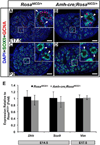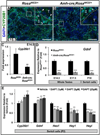Constitutive activation of NOTCH1 signaling in Sertoli cells causes gonocyte exit from quiescence
- PMID: 23391689
- PMCID: PMC3630254
- DOI: 10.1016/j.ydbio.2013.01.031
Constitutive activation of NOTCH1 signaling in Sertoli cells causes gonocyte exit from quiescence
Abstract
Notch signaling components have long been detected in Sertoli and germ cells in the developing and mature testis. However, the role of this pathway in testis development and spermatogenesis remains unknown. Using reporter mice expressing green fluorescent protein following Notch receptor activation, we found that Notch signaling was active in Sertoli cells at various fetal, neonatal, and adult stages. Since Notch signaling specifies stem cell fate in many developing and mature organ systems, we hypothesized that maintenance and differentiation of gonocytes and/or spermatogonial stem cells would be modulated through this pathway in Sertoli cells. To this end, we generated mutant mice constitutively expressing the active, intracellular domain of NOTCH1 (NICD1) in Sertoli cells. We found that mutant Sertoli cells were morphologically normal before and after birth, but presented a number of functional changes that drastically affected gonocyte numbers and physiology. We observed aberrant exit of gonocytes from mitotic arrest, migration toward cord periphery, and premature differentiation before birth. These events, presumably unsupported by the cellular microenvironment, were followed by gonocyte apoptosis and near complete disappearance of the gonocytes by day 2 after birth. Molecular analysis demonstrated that these effects are correlated with a dysregulation of Sertoli-expressed genes that are required for germ cell maintenance, such as Cyp26b1 and Gdnf. Taken together, our results demonstrate that Notch signaling is active in Sertoli cells throughout development and that proper regulation of Notch signaling in Sertoli cells is required for the maintenance of gonocytes in an undifferentiated state during fetal development.
Copyright © 2013 Elsevier Inc. All rights reserved.
Figures









References
-
- Artavanis-Tsakonas S, Muskavitch MA. Notch: the past, the present, and the future. Curr Top Dev Biol. 2010;92:1–29. - PubMed
-
- Barrionuevo F, Georg I, Scherthan H, Lecureuil C, Guillou F, Wegner M, Scherer G. Testis cord differentiation after the sex determination stage is independent of Sox9 but fails in the combined absence of Sox9 and Sox8. Dev Biol. 2009;327:301–312. - PubMed
-
- Basciani S, De Luca G, Dolci S, Brama M, Arizzi M, Mariani S, Rosano G, Spera G, Gnessi L. Platelet-derived growth factor receptor beta-subtype regulates proliferation and migration of gonocytes. Endocrinology. 2008;149:6226–6235. - PubMed
-
- Bingham NC, Verma-Kurvari S, Parada LF, Parker KL. Development of a steroidogenic factor 1/Cre transgenic mouse line. Genesis. 2006;44:419–424. - PubMed
Publication types
MeSH terms
Substances
Grants and funding
LinkOut - more resources
Full Text Sources
Other Literature Sources
Molecular Biology Databases

